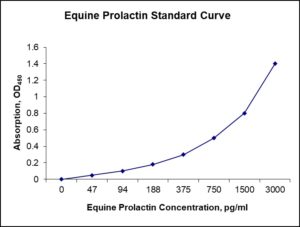Nori Equine Prolactin ELISA Kit
$461.00 – $832.00
This ELISA kit is for quantification of prolactin in horse. This is a quick ELISA assay that reduces time to 50% compared to the conventional method, and the entire assay only takes 3 hours. This assay employs the quantitative sandwich enzyme immunoassay technique and uses biotin-streptavidin chemistry to improve the performance of the assays. An antibody specific for PRL has been pre-coated onto a microplate. Standards and samples are pipetted into the wells and any PRL present is bound by the immobilized antibody. After washing away any unbound substances, a detection antibody specific for PRL is added to the wells. Following wash to remove any unbound antibody reagent, a detection reagent is added. After intensive wash a substrate solution is added to the wells and color develops in proportion to the amount of PRL bound in the initial step. The color development is stopped, and the intensity of the color is measured.
Alternative names for prolactin: PRL, lactotrope
This product is for laboratory research use only not for diagnostic and therapeutic purposes or any other purposes.
- Description
- How Elisa Works
- Product Citation (0)
- Reviews (0)
Description
Nori Equine Prolactin ELISA Kit Summary
Alternative names for prolactin: PRL, lactotrope
Alternative name for equine: Horse
| Assay Type | Solid Phase Sandwich ELISA |
| Format | 96-well Microplate or 96-Well Strip Microplate |
| Method of Detection | Colorimetric |
| Number of Targets Detected | 1 |
| Target Antigen Accession Number | na |
| Assay Length | 3 hours |
| Quantitative/Semiquantitative | Quantitative |
| Sample Type | Plasma, Serum, Cell Culture, Urine, Cell/Tissue Lysates, Synovial Fluid, BAL, |
| Recommended Sample Dilution (Plasma/Serum) | No dilution for sample <ULOQ; sufficient dilution for samples >ULOQ |
| Sensitivity | 9 ng/mL |
| Detection Range | 46.88-3000 ng/mL |
| Specificity | Equine prolactin |
| Cross-Reactivity | < 0.5% cross-reactivity observed with available related molecules, < 50% cross-species reactivity observed with species tested. |
| Interference | No significant interference observed with available related molecules |
| Storage/Stability | 4 ºC for up to 6 months |
| Usage | For Laboratory Research Use Only. Not for diagnostic or therapeutic use. |
| Additional Notes | The kit allows for use in multiple experiments. |
Standard Curve
Kit Components
1. Pre-coated 96-well Microplate
2. Biotinylated Detection Antibody
3. Streptavidin-HRP Conjugate
4. Lyophilized Standards
5. TMB One-Step Substrate
6. Stop Solution
7. 20 x PBS
8. Assay Buffer
Other Materials Required but not Provided:
1. Microplate Reader capable of measuring absorption at 450 nm
2. Log-log graph paper or computer and software for ELISA data analysis
3. Precision pipettes (1-1000 µl)
4. Multi-channel pipettes (300 µl)
5. Distilled or deionized water
Protocol Outline
1. Prepare all reagents, samples and standards as instructed in the datasheet.
2. Add 100 µl of Standard or samples to each well and incubate 1 h at RT.
3. Add 100 µl of Working Detection Antibody to each well and incubate 1 h at RT.
4. Add 100 µl of Working Streptavidin-HRP to each well and incubate 20 min at RT.
5. Add 100 µl of Substrate to each well and incubate 5-30 min at RT.
6. Add 50 µl of Stop Solution to each well and read at 450 nm immediately.
Background:
Prolactin (PRL), also known as lactotrope, is a protein that in humans is encoded by the PRL gene. [1] Although it is perhaps best known for its role in lactation, prolactin already existed in the oldest known vertebrates—fish—where its most important functions were probably related to control of water and salt balance. It stimulates the mammary glands to produce milk: Increased serum concentrations of prolactin during pregnancy cause enlargement of the mammary glands of the breasts and prepare for the production of milk. Prolactin also acts in a cytokine-like manner and as an important regulator of the immune system. Prolactin has important cell cycle related functions as a growth-, differentiating- and anti-apoptotic factor. As a growth factor binding to cytokine like receptors it has also profound influence on hematopoiesis, angiogenesis and is involved in the regulation of blood clotting through several pathways. More than 300 separate actions of PRL have been reported in various vertebrates.[2] Prolactin acts in endocrine, autocrine, and paracrine manner through the prolactin receptor and a large number of cytokine receptors.[2] Pituitary prolactin secretion is regulated by endocrine neurons in the hypothalamus, the most important ones being the neurosecretory tuberoinfundibulum (TIDA) neurons of the arcuate nucleus, which secrete dopamine to act on the D2 receptors of lactotrophs, causing inhibition of prolactin secretion. Many fishes have variants prolactin A and prolactin B. In humans 3 smaller (4, 16, and 22 kDa) and several larger variants exist. Highly elevated levels of prolactin decrease the levels of sex hormones — estrogen in women and testosterone in men. In humans, prolactin is produced at least in the pituitary, decidua, myometrium, breast, lymphocytes, leukocytes and prostate.[3][4] Prolactin levels may be checked as part of a sex hormone workup, as elevated prolactin secretion can suppress the secretion of FSH and GnRH, leading to hypogonadism, and sometimes causing erectile dysfunction in men. Prolactin levels may be of some use in distinguishing epileptic seizures from psychogenic non-epileptic seizures. The serum prolactin level usually rises following an epileptic seizure.[5]
References
- Evans AM, et al. (1989). Somat. Cell Mol. Genet. 15 (3): 203–13.
- Bole-Feysot C, et al. (1998). Endocr. Rev. 19 (3): 225–68.
- Ben-Jonathan N, et al (1996). Endocr. Rev. 17 (6): 639–69.
- Gerlo S, et al (2006). “Prolactin in man: a tale of two promoters”. Bioessays 28 (10): 1051–5.
- Banerjee S, et al. (2004). “Serum prolactin in seizure disorders”. Indian Pediatr 41(8): 827–31.
Be the first to review “Nori Equine Prolactin ELISA Kit”
You must be logged in to post a review.




























Reviews
There are no reviews yet.